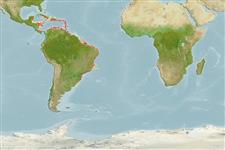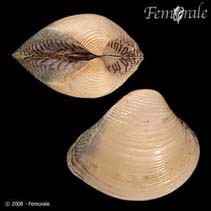Anomalocardia brasiliana (Gmelin, 1791)
West Indian pointed venus| Native range | All suitable habitat | Point map | Year 2050 |

|
| This map was computer-generated and has not yet been reviewed. |
| Anomalocardia brasiliana AquaMaps Data sources: GBIF OBIS |
Classification / Names Common names | Synonyms | CoL | ITIS | WoRMS
Bivalvia | Venerida | Veneridae
Environment: milieu / climate zone / depth range / distribution range Ecology
Benthic; brackish; depth range 0 - 5 m (Ref. 83435). Tropical; 21°N - 35°S, 89°W - 34°W
Distribution Countries | FAO areas | Ecosystems | Occurrences | Introductions
Western Atlantic: Caribbean Sea to Brazil, subtropical south America; 16°N to 33°S.
Length at first maturity / Size / Weight / Age
Maturity: Lm ?, range 1 - ? cm Max length : 3.7 cm SHL male/unsexed; (Ref. 130712); max. reported age: 3.00 years (Ref. 104267)
Found in the intertidal zone to a depth of 1.5 m (Ref. 104267). Lives slightly buried in muddy sands of shallow water environments, particularly in mangrove lagoons (Ref. 81903). Adults prefer to settle in areas with fine or coarse sand where conditions are harsher during low tide (Ref. 104267). Strictly a filter-feeder (Ref. 104242). Suspension feeder (Ref. 105167). In general, suspension feeding bivalves mainly depend on phytoplankton and detritus material for nutrition (Ref. 107088). Sensitive to salinity variations but resistant to hypoxic conditions (Ref. 104267). Associated with a crab (Refs. 104147, 105309), bivalve and polychaetes (Ref.105309).
Life cycle and mating behavior Maturity | Reproduction | Spawning | Eggs | Fecundity | Larvae
Members of the class Bivalvia are mostly gonochoric, some are protandric hermaphrodites. Life cycle: Embryos develop into free-swimming trocophore larvae, succeeded by the bivalve veliger, resembling a miniature clam (Ref. 833).
Main reference
References | Coordinator | Collaborators
Barreira, C.A.R. and M.L.R. Araújo. 2005. (Ref. 81737)
IUCN Red List Status (Ref. 130435)
CITES status (Ref. 108899)
Not Evaluated
CMS (Ref. 116361)
Not Evaluated
Threat to humans
Human uses
Fisheries: commercial
| FishSource |
Tools
More information
Internet sources
BHL | BOLD Systems | CISTI | DiscoverLife | FAO(Publication : search) | Fishipedia | GenBank (genome, nucleotide) | GloBI | Gomexsi | Google Books | Google Scholar | Google | PubMed | Tree of Life | Wikipedia (Go, Search) | Zoological Record
Estimates based on models
Preferred temperature
(Ref. 115969): 22.6 - 28.4, mean 27.5 (based on 264 cells).
Resilience
(Ref. 69278):
High, minimum population doubling time less than 15 months (K=0.69; tmax=3).



